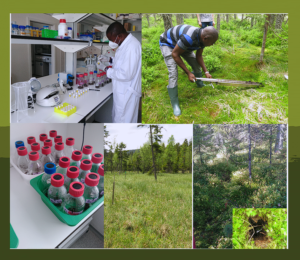Even though peatlands cover only 3% of Earth’s land surface, they store nearly one-third of global soil carbon and serve as both sources and sinks of methane. Here, methanogens produce methane, while methanotrophs consume up to 70% of the potent greenhouse gas. The study “Regulators of aerobic and anaerobic methane oxidation in two pristine temperate peatland types“ in FEMS Microbiology Ecology investigated how methanotrophic communities in two peatlands respond to important environmental factors. To mark World Peatland Day, Justus Nweze explains why we need to better understand the dynamics of aerobic and anaerobic methane oxidation in peatland systems. #MicrobiologyIsEverywhere
Understanding methane oxidation pathways
Methanotroph microorganisms provide a crucial service as they consume methane and consequently reduce greenhouse gas emission. They do so through two major pathways: aerobic and anaerobic methane oxidation.
Aerobic methane oxidation occurs in oxygen-rich upper peat layers, primarily facilitated by bacteria. On the other hand, anaerobic methane oxidation occurs in oxygen-depleted layers. Here, archaea and bacteria use alternative electron acceptors, such as sulfate or ferric iron.
These two metabolic processes are influenced by environmental factors and conditions. Additionally, human activities, like drainage and pollution, can further influence methane emissions, sometimes even to the point of threatening important ecosystems like peatlands. That’s why studying peatlands is crucial to understanding their roles in the global carbon cycle and responses to climate change, as disruptions can release large amounts of stored carbon.
However, the extent and nature of human influence on different peat systems remain unclear. That’s why the article “Regulators of aerobic and anaerobic methane oxidation in two pristine temperate peatland types“ in FEMS Microbiology Ecology investigated how various environmental factors impact microbial activities in peatland systems. The study sampled and incubated peat soil from two peatlands—a fen and a spruce swamp forest—both located in the Bohemian Forest National Park, Czech Republic.

Effect of ammonium on aerobic methane oxidation
The first question was whether ammonium addition, at levels comparable to current anthropogenic nitrogen pollution, would impact aerobic methane oxidation by microbes. Contrary to expectations, incubating the soil with ammonium for up to 50 days had no stimulatory effect, suggesting that methanotrophs were not nitrogen-limited.
Furthermore, methane consumption was higher in the fen than in the swamp, likely due to a more abundant and diverse methanotrophic community. This aligns with the generally higher methane production potential of fens.
Electron acceptor preference in anaerobic methane oxidation
To better understand the dynamics of anaerobic methane oxidation, researchers added sulfate and ferric iron to the peat. These served as electron acceptors alternatively of oxygen in methanotrophs.
In the fen, anaerobic methane oxidation occurred naturally without these external electron acceptors. This suggested that both the anaerobic methane oxidizers and the required electron acceptors were present.
However, anaerobic methane oxidation in the swamp only occurred after adding sulfate or ferric iron. These results suggest that the microbes capable of anaerobic methane oxidation reside in both peat types, highlighting the varying requirements for methane oxidation between fen and swamp peatland types.
Identifying methanotrophic communities in peatlands
The microbial communities from the peat soil samples were dominated by Methylocystis and Methylocella. Interestingly, no anaerobic methanotrophic archaea were detected that might be responsible for the observed anaerobic methane oxidation.

Notably, some aerobic methanotrophs appeared to contribute to anaerobic methane oxidation due to the increased relative abundance of the 16S genes of Methylocystis-like and Methylomonas-like aerobic methanotrophs. These findings hint at the metabolic flexibility of these microbes.
This study identified factors that regulate methane oxidation in peatland soil, such as microbial diversity, nutrient availability, and electron acceptors. This knowledge can help scientists predict how peatlands will respond to environmental changes. By refining global methane budgets and developing strategies to mitigate greenhouse gas emissions, peatlands can be essential contributors to climate change mitigation efforts.
Happy World Peatland Day!
- Read the article “Regulators of aerobic and anaerobic methane oxidation in two pristine temperate peatland types“ in FEMS Microbiology Ecology by Nweze et al. (2024).
About the author
 Justus Nweze obtained his Bachelor’s and Master’s degrees in Microbiology and Medical Microbiology, respectively, from the University of Nigeria, Nsukka. He is currently a PhD candidate in Ecosystem Biology and Ecology at the University of South Bohemia at the Biology Centre in České Budějovice, Czech Republic. His research focuses on microbial ecology in peatland soils, particularly methane cycling and methanotrophy under varying environmental conditions. Using techniques such as 16S rRNA sequencing, metagenomics, and stable isotope probing, he investigates the diversity and activity of methane-oxidizing bacteria. Additionally, he explores novel methanotrophs, their genomic adaptations, and resilience to acid stress.
Justus Nweze obtained his Bachelor’s and Master’s degrees in Microbiology and Medical Microbiology, respectively, from the University of Nigeria, Nsukka. He is currently a PhD candidate in Ecosystem Biology and Ecology at the University of South Bohemia at the Biology Centre in České Budějovice, Czech Republic. His research focuses on microbial ecology in peatland soils, particularly methane cycling and methanotrophy under varying environmental conditions. Using techniques such as 16S rRNA sequencing, metagenomics, and stable isotope probing, he investigates the diversity and activity of methane-oxidizing bacteria. Additionally, he explores novel methanotrophs, their genomic adaptations, and resilience to acid stress.
The section #MicrobiologyEvents for the #FEMSmicroBlog reports about events and meetings relevant to our network. These include world awareness days, FEMS-sponsored meetings or meetings of Member Societies and many more.
| DO YOU WANT TO BE A GUEST CONTRIBUTOR? |
| The #FEMSmicroBlog welcomes external bloggers, writers and SciComm enthusiasts. Get in touch if you want to share your idea for a blog entry with us! |
